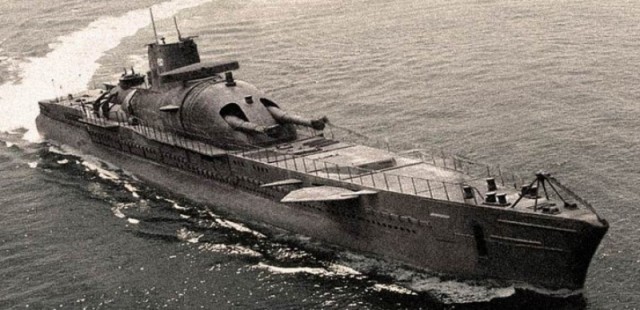
Surcouf was a French submarine ordered to be built in December 1927, launched on 18 October 1929, and commissioned in May 1934. Surcouf – named after the French privateer Robert Surcouf – was the largest submarine ever built until surpassed by the first Japanese I-400-class submarine in 1943. Her short wartime career was marked with controversy and conspiracy theories. She was classified as an “undersea cruiser” by sources of her time.
In 1940, Surcouf was based in Cherbourg, but in May, when the Germans invaded, she was being refitted in Brest. With only one engine functioning and with a jammed rudder, she limped across the English Channel and sought refuge in Plymouth.
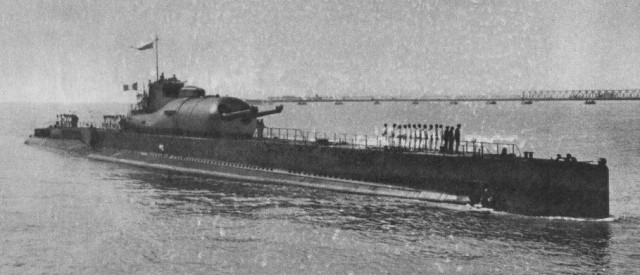
On 3 July, the British, concerned that the French Fleet would be taken over by the German Kriegsmarine at the French armistice, executed Operation Catapult. French ships lying at ports in Britain and Canada were also boarded by armed marines, sailors and soldiers, and the only serious incident took place at Plymouth aboard Surcouf, when two Royal Navy submarine officers, Cdr Denis ‘Lofty’ Sprague, captain of HMS Thames and Lt Griffiths of HMS Rorqual, and French warrant officer mechanic Yves Daniel were fatally wounded, and a British seaman, LS Webb was shot dead by the submarine’s doctor.
The acrimony between the British and French caused by these actions escalated when the British attempted to repatriate the captured French sailors: the British hospital ship that was carrying them back to France was sunk by the Germans, and many of the French blamed the British for the deaths.
By August 1940, the British completed Surcouf ’s refit and turned her over to the Free French Navy for convoy patrol. The only officer not repatriated from the original crew, Capitaine de Frégate (Commander) Georges Louis Blaison, became the new commanding officer. Because of the British-French tensions with regard to the submarine, accusations were made by each side that the other was spying for Vichy France; the British also claimed that Surcouf was attacking British ships. Later, a British officer and two sailors were put on board for “liaison” purposes. One real drawback of this submarine was that it required a crew of 110–130 men, which represented three crews of more conventional submarines.
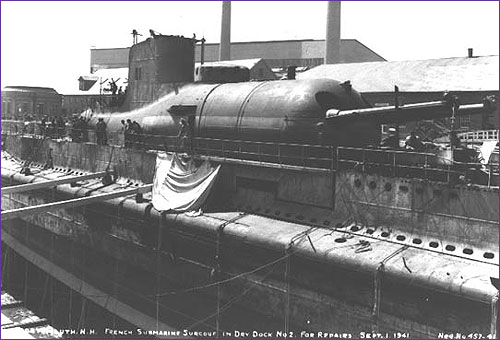 Surcouf in dry dock for repairs, September 1, 1941. Source
Surcouf in dry dock for repairs, September 1, 1941. SourceOn 28 July, Surcouf went to the United States Naval Shipyard at Portsmouth, New Hampshire for a three-month refit. The U.S. was technically violating its neutrality as the U.S. had diplomatic relations with Vichy France at the time and did not recognize Free France.
After leaving the shipyard, Surcouf went to New London, Connecticut, presumably to receive additional training for her crew. Surcouf left New London on 27 November to return to Halifax.
In January 1942, the Free French decided to send Surcouf to the Pacific theatre of war, after she re-supplied at Bermuda. Her movement south triggered rumours that she was going to liberate Martinique for the Free French from Vichy.
After the outbreak of war with Japan, Surcouf was ordered to Sydney, Australia via Tahiti. She departed Halifax on 2 February for Bermuda, which she left on 12 February, bound for the Panama Canal.
Surcouf may have been sunk on 18 February 1942 about 80 miles north of Cristóbal, Colón, while en route for Tahiti via the Panama Canal. The American freighter Thompson Lykes, steaming alone from Guantanamo Bay on what was a very dark night, reported hitting and running down a partially submerged object which scraped along her side and keel. Her lookouts heard people in the water but the freighter carried on its course without stopping, as they thought that they had struck a German U-boat, though cries for help were heard in English. A signal was sent to Panama describing the incident. The loss of Surcouf was announced by the Free French Headquarters in London on 18 April 1942.
Theories
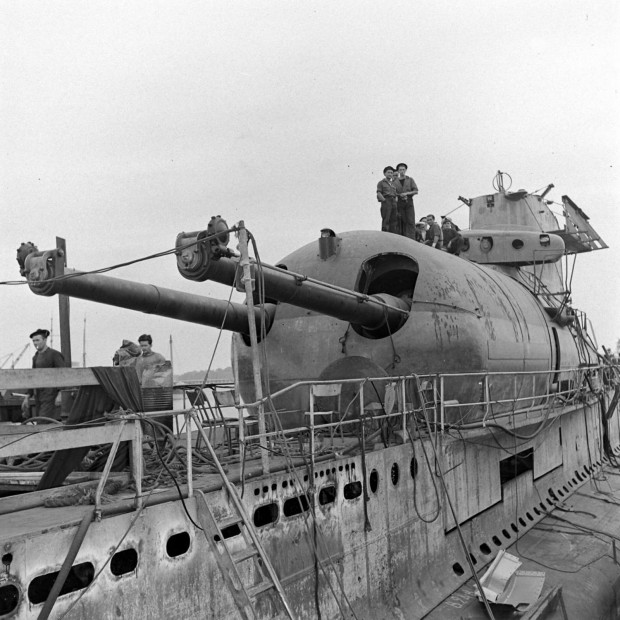
Inquiries into the incident were haphazard and late, while a later French inquiry supported the idea that the sinking had been due to “friendly fire”; this conclusion was supported by Rear Admiral Auphan in his book The French Navy in World War II in which he states: “for reasons which appear to have been primarily political, she was rammed at night in the Caribbean by an American freighter.” Charles de Gaulle stated in his memoirs that Surcouf “had sunk with all hands”.
A memo from FBI Director J. Edgar Hoover to the chief of U.S. Naval Intelligence dated March 12, 1942 states that a “highly confidential source” had confirmed that Surcouf had been sunk near St. Pierre. It was not specified if St. Pierre was the island near Newfoundland or the city in Martinique. It has been speculated that the source of the information was Sir William Stephenson the head of British counter-intelligence in North America and the subject of the book A Man Called Intrepid.
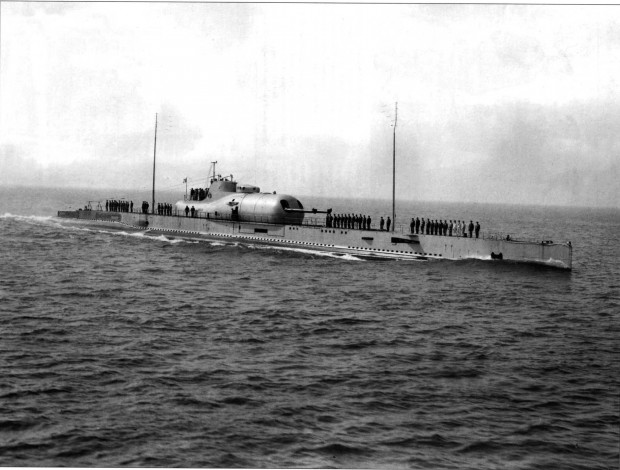
Many stories add that much of the gold from the French Treasury was in Surcouf ’s large cargo compartment, and that the wreck was found and entered in 1967 by Jacques Cousteau. This story was debunked by Captain Grigore when he wrote to Cousteau asking if Cousteau’s diving saucer could be used to search for Surcouf. Cousteau replied that the depth of Surcouf’s presumed location is beyond the test depth of the diving saucer.
Amateur scuba diver Lee Prettyman, Jr., founder of the Gillmen Dive Club of Groton, Connecticut, reported finding the wreck of Surcouf in Long Island Sound in 1965. Prettyman’s discovery was reported in an article in the January 1967 edition of Argosy magazine. There was also a newspaper article about it with his picture in the Hartford Courant. It has been said that the article was later retracted after threats were reportedly made. As there are several submarine wrecks in Long Island Sound, including USS Bass, USS L-8 and USS S-51, it is quite possible that Prettyman discovered the wreck of a submarine other than Surcouf.
James Rusbridger examined some of the theories in his book Who Sank Surcouf?, finding them all easily dismissed except one: the records of the 6th Heavy Bomber Group operating out of Panama show them sinking a large submarine the morning of 19 February. Since no German submarine was lost in the area on that date, it could only have been Surcouf. He suggested that the collision had damaged Surcouf ’s radio and the stricken boat limped towards Panama hoping for the best.

Δεν υπάρχουν σχόλια:
Δημοσίευση σχολίου